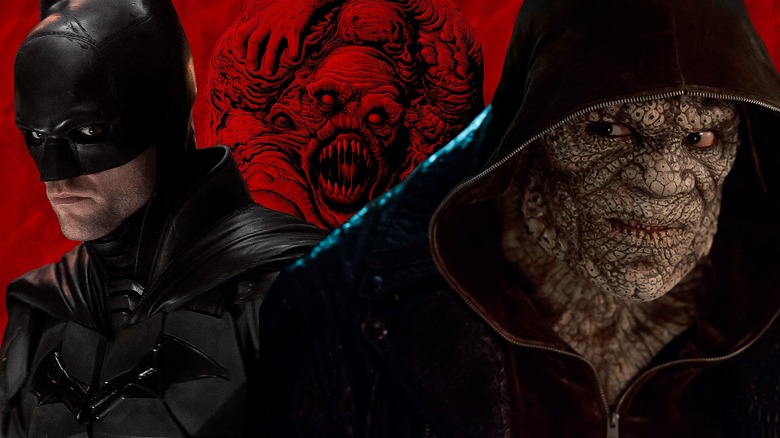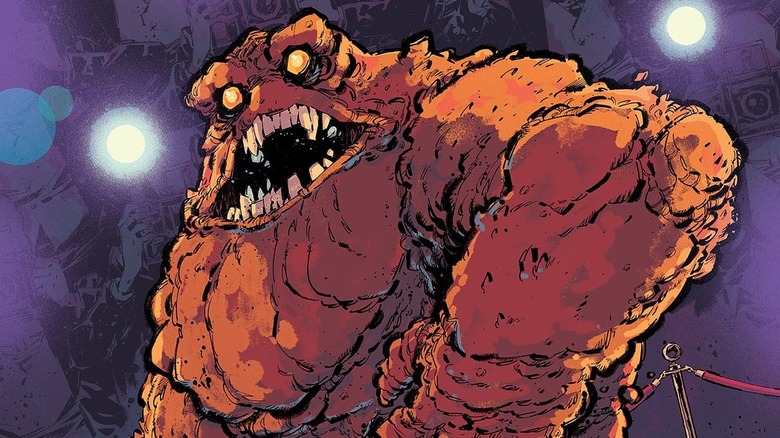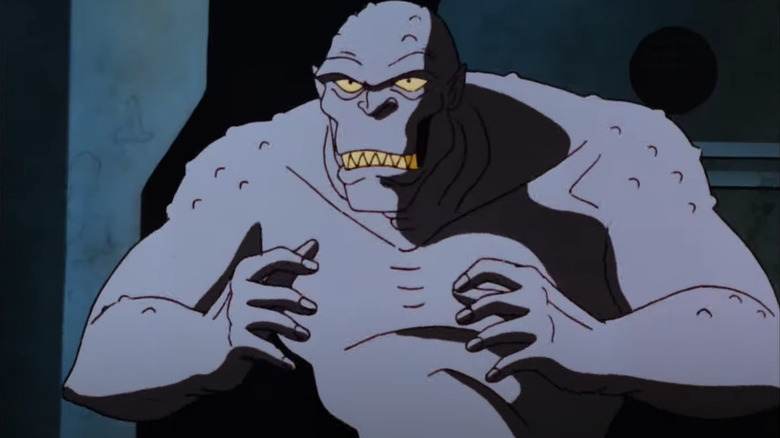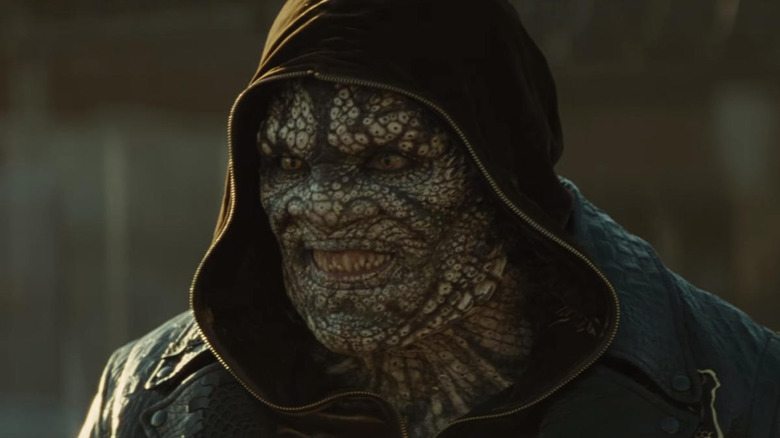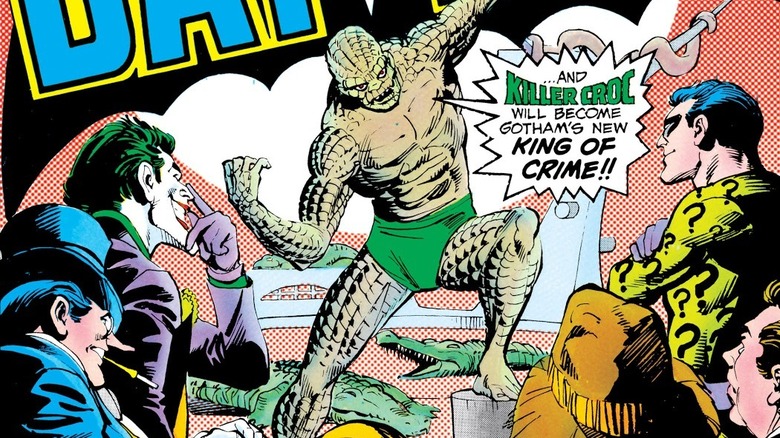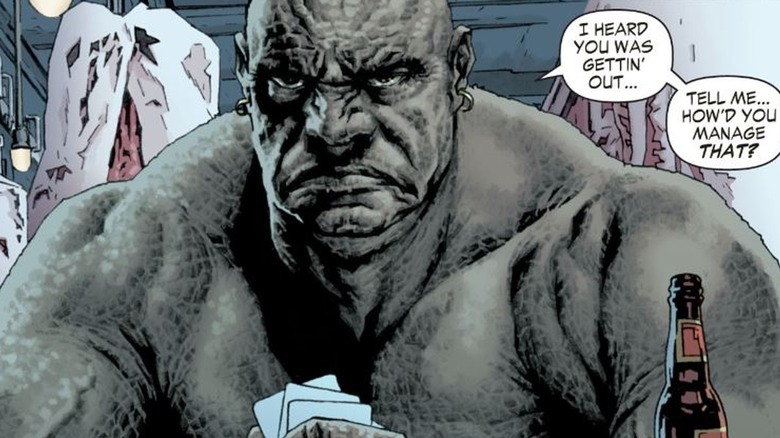Killer Croc Is The Perfect Batman 2 Villain (& Clayface Would Be A Mistake)
Matt Reeves' "The Batman" has a unique place in the world of DC films. Since the 2022 movie and its upcoming sequel exist outside the confines of not only the now-defunct Snyderverse but also James Gunn's upcoming retooled DCU, Robert Pattinson's young Batman can explore the mythos in a far more somber way, free from all ties to the wider superhero world. Thus far, the result has been Batman's most grounded, noir-tinged live-action universe to date, and a rogues' gallery built of true misfits instead of the suave figures of past franchises, with Paul Dano's Zodiac killer-inspired Riddler leading the charge alongside Collin Farrell's mobster take on the Penguin and a gruesome glimpse of Barry Keoghan's Joker.
For the upcoming "The Batman – Part II," Riddler is a tough act to follow — and industry buzz indicates that Reeves may be making things doubly difficult for himself by bringing in Clayface. The shape-shifting monster villain would definitely be a very different antagonist from Dano's murderous manchild, and while it's fun to speculate on what a grounded Clayface might look like, it's worth asking — why twist Batman's most sci-fi bad guy into a realistic mold, when the most popular depiction of the character is anything but?
After all, there's another big, strong Batman villain who would fit Reeves' vision like a glove ... and who just so happens to be in dire need of live-action redemption. What we're saying is that "The Batman — Part II" should shelve Clayface, and bring in Killer Croc. Here's why.
Clayface is the one Batman villain who can't (and shouldn't) be toned down
The origins of Clayface are about as complicated as a comic book character can get, but thanks to an array of reboots and media adaptations, the version of the character that fans have come to love is the tragic, complex story of a once-famous movie star who is turned into a hulking, shape-shifting clay creature. That is, specifically, the Clayface famously voiced by Ron Perlman in "Batman: The Animated Series."
That Clayface is far more rooted in sci-fi and horror than almost any other Batman antagonist, but to be fair, there is a more grounded version that presumably would be the inspiration for "The Batman — Part II" — the original incarnation, Basil Karlo, an actor who dons a creepy mask and recreates the murders in his star-making movie.
Now, would a serial killer character like this be accurate to the comics? Sure. But that's not the Clayface that people have been dying to see on-screen for years. And using this realistic Clayface in the Reevesverse would essentially lock out the sci-fi Clayface from James Gunn's DCU proper for the next decade. Which would be a huge shame, because a giant mud monster is exactly the sort of quirky character that Gunn does best — and with "The Brave and the Bold" about to introduce a new Batman (and Robin) in the mix, it would be a travesty to strip the DCU of that opportunity.
Killer Croc, meanwhile, would benefit from a grounded approach
So, now that we've established why Reeves should avoid Clayface, let's examine why Killer Croc belongs in the Reeves-verse instead of James Gunn's DCU.
The last time we saw Killer Croc on the big screen, he was part of David Ayer's ill-fated "Suicide Squad." Played by Adewale Akinnuoye-Agbaje under a ton of special effects prosthetics, the villain cuts an imposing figure ... but does next to nothing, and is ultimately buried under the weight of the movie's blandness. A live-action Croc also appeared on CW's "Batwoman," again as a toothy, reptilian monstrosity.
Yet, unlike Clayface — an outlandish monster who is crying out for a big-budget, CGI-heavy tentpole treatment — Croc is a character that would benefit greatly from going back to basics. Forget about the exaggerated dinosaur appearance that most contemporary depictions of Waylon Jones play up, with the tail and claws: doing that in live-action will just feel a rip-off of the Lizard in the "Spider-Man" films. Instead, consider his backstory. Waylon Jones, as originally written, is a regular guy with a skin condition that has turned him into an outcast, and he only becomes a villain after the world ostracizes him. He's not terrorizing Gotham because he likes it, or because he's on a mission. More often than not, he's doing it because that's the only option life has left him with.
This is already a perfect opportunity for the kind of social class juxtaposition "The Batman" is so fond of, only with a brand-new angle and a radically different antagonist. As far as character design, "The Batman — Part II" can just accentuate his skin condition while ditching the overtly lizard-like touches, and suddenly, you have a perfect antagonist for "The Batman — Part II."
Suicide Squad wasted Killer Croc, and the character deserves better
All that complexity and pathos and personal tragedy we mentioned earlier? The average moviegoer knows absolutely nothing of all this, because all they've seen is that "Suicide Squad" version of Killer Croc — a take on the character that disappointed a great many fans.
This is doubly infuriating because the "Suicide Squad" version had all the makings of a Croc for the ages. The design, while clunky, is certainly horrifying. Akinnuoye-Agbaje is a bona fide legend when it comes to portraying imposing figures with a complex nature, as he's proved in his roles as Simon Adebisi in "Oz" and Mr. Eko in "Lost." Here, sadly, he got stuck taking the same route he was forced to walk in "Thor: The Dark World" as Kurse — hindered by a ton of heavy special effects makeup, as well as a script that doesn't really allow him to do anything other than punch and scowl. In these circumstances, nuanced portrayal can be ... challenging, to say the least.
It's true that "Suicide Squad" doesn't do any favors for the majority of its characters — hi, Jared Leto's Joker — but out of the core members of the team, Croc gets arguably the worst deal of them all. Even Slipknot (Adam Beach) gets a memorable death scene in his brief moment of screen time. Croc is simply boring, which is a true accomplishment for a hulking crocodile man played by an actor of Akinnuoye-Agbaje's caliber. And frankly, Croc deserves a bigger role than just being a one-note member of a villain team.
The original Killer Croc is far from a mindless monster, and even the comics have forgotten that
The thing about making Killer Croc more realistic is that it wouldn't even be a reimagining of the character — it would just take him back to his roots.
When the comic book version of Killer Croc debuted in 1983, he was a huge deal in Gotham's criminal underworld, and remained one of the biggest threats to the Dark Knight for the better part of a decade. He wasn't a monstrous opponent — just a crafty, intelligent mobster with a skin condition. However, Croc's portrayal changed in a pretty dramatic way in the 1990s, when a certain masked villain called Bane started making moves and breaking bat-backs. Bane has fairly consistently been portrayed as a powerhouse who also happens to be quite intelligent, so he was already sort of stepping on Croc's toes. It didn't help that he quite literally beat Croc up as a way to establish himself in 1993's "Batman: Knightfall."
Croc's public image never really recovered from this particular beatdown. With Bane now occupying the "strong but smart" niche, writers tried to differentiate Killer Croc by making him a mindless, mutated dinosaur. The readers, though, do remember the old ways. Even the most cursory glance at online Batman conversations will yield fans who would love to see Croc return to his original portrayal, complete with his tragic backstory. It makes sense, too. What better way to portray this sort of character than to explore the humanity within? Even without going into the problematic nature of contemporary Killer Croc portrayals — that is, depicting an impoverished character with mental health problems as being a mindless monster — Croc simply works better as a nuanced character.
Brian Azzarello and Lee Bermejo have already given us the perfect Matt Reeves Killer Croc
Matt Reeves, if you're reading this, and you're interested in Killer Croc, you don't have to spend weeks reading all of his comic appearances to date in search of the right formula. Because the perfect blueprint for a "The Batman"-style Waylon Jones already exists in the 2008 graphic novel "Joker" by writer Brian Azzarello and artist Lee Bermejo.
"Joker" is an intense, deep dive into Gotham City's underworld, seen through the eyes of newly minted Joker henchman Jonny Frost. While the book obviously concentrates on the guy it's named after, several prominent Batman villains also appear, remolded into more realistic versions of themselves, and the clear winner in this reimagining game is Killer Croc. Here, Jones is simply a tall, muscular man with no superpowered attributes, born with a skin condition that leaves his epidermis with a hard, cracked scaly appearance. Leaning into this imagery, Jones files his teeth into points, and has a reputation for being a cannibal who makes his enemies disappear exactly how you'd imagine. Most importantly, he's extremely cunning — so dangerous, in fact, that even the Joker treads somewhat lightly around him.
When it comes to realistic and terrifying portrayals of Killer Croc, few others can touch him. As such, Azzarello's Croc could — no, should — act as a blueprint for the bad guy that we hope will appear in "The Batman — Part II," whether as a supporting villain or the big bad.
